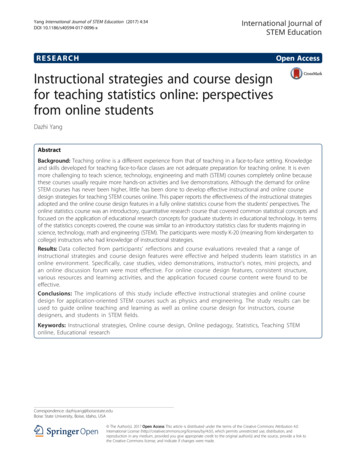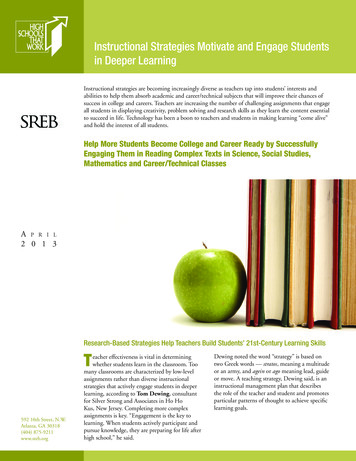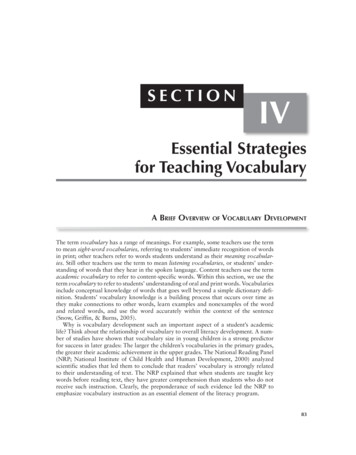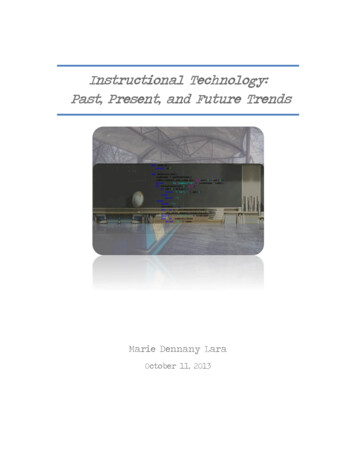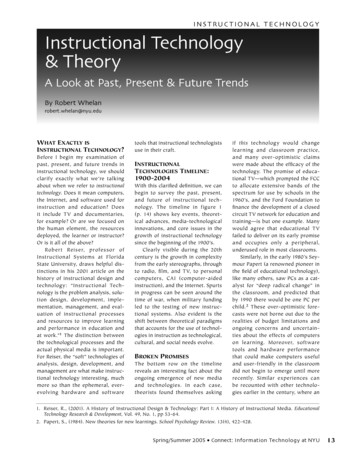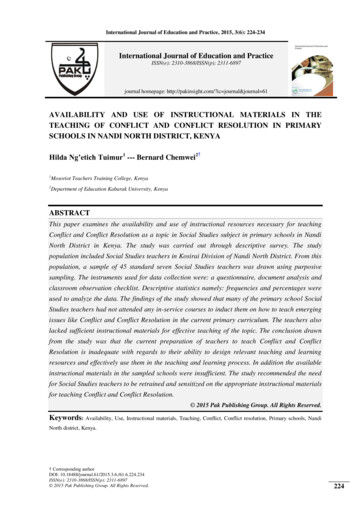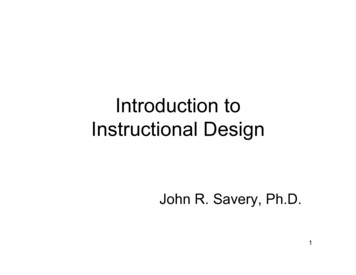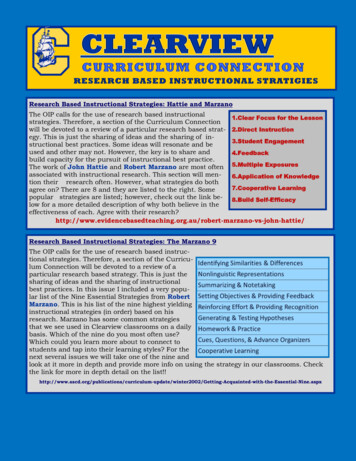
Transcription
Research Based Instructional Strategies: Hattie and MarzanoThe OIP calls for the use of research based instructional1.Clear Focus for the Lessonstrategies. Therefore, a section of the Curriculum Connectionwill be devoted to a review of a particular research based strat- 2.Direct Instructionegy. This is just the sharing of ideas and the sharing of in3.Student Engagementstructional best practices. Some ideas will resonate and beused and other may not. However, the key is to share and4.Feedbackbuild capacity for the pursuit of instructional best practice.The work of John Hattie and Robert Marzano are most often 5.Multiple Exposuresassociated with instructional research. This section will men6.Application of Knowledgetion their research often. However, what strategies do both7.Cooperative Learningagree on? There are 8 and they are listed to the right. Somepopular strategies are listed; however, check out the link be- 8.Build Self-Efficacylow for a more detailed description of why both believe in theeffectiveness of each. Agree with their obert-marzano-vs-john-hattie/Research Based Instructional Strategies: The Marzano 9The OIP calls for the use of research based instructional strategies. Therefore, a section of the Curriculum Connection will be devoted to a review of aparticular research based strategy. This is just thesharing of ideas and the sharing of instructionalbest practices. In this issue I included a very popular list of the Nine Essential Strategies from RobertMarzano. This is his list of the nine highest yieldinginstructional strategies (in order) based on hisresearch. Marzano has some common strategiesthat we see used in Clearview classrooms on a dailybasis. Which of the nine do you most often use?Which could you learn more about to connect tostudents and tap into their learning styles? For thenext several issues we will take one of the nine andlook at it more in depth and provide more info on using the strategy in our classrooms. Checkthe link for more in depth detail on the ntial-Nine.aspx
Research Based Instructional Strategies: FeedbackThe OIP calls for the use of research based instructional strategies. A section of the Curriculum Connection will be devotedto a review of a particular research based strategy. In this issue I reviewed one of the Marzano 9: Feedback. Teachersknow that feedback is critical for their students; however,what do researchers say are effective strategies for feedback?What resonates with students for effective learning? The linkbelow identifies 7 key characteristics of effective feedbackfrom educator and author Grant Wiggins. How is feedbackused in our Clipper search Based Instructional Strategies: Nonlinguistic RepresentationThe OIP calls for the use of research based instructional strategies. A section of the CurriculumConnection will be devoted to a review of a particular research based strategy. In this issue I willcontinue to review another of the Marzano 9: Nonlinguistic Representation. What is it?Non-linguistic knowledge focuses on storing information using mental pictures, images, andphysical sensations. Studies have shown that teachers primarily use linguistic methods toconvey knowledge to their students. Teachersmust understand that students need an equal balance of linguistic and non-linguisticmethods inevery-day learning experiences. The key is to produce non-linguistic representations in the mindsof students for long-term memory. It goes with theold saying “A picture is worth a thousand words.”For a learner that could be very true. The mostcommon example that teachers are probably awareis the use of graphic organizers, example: VennDiagrams. How do Clearview teachers use nonlinguistic representation in our classrooms? Is therea balance between words/phases and nonlinguistic? Check out the link below to learn geNonlinguistically.aspxResearch Based Instructional Strategies: Identifying Similarities and DifferencesThe OIP calls for the use of research based instructional strategies. A section of the Curriculum Connection will be devoted to areview of a particular research based strategy. In this fifth issue Iwill review another of the Marzano 9: Identifying Similarities andDifferences. This strategy actually falls #1 on the chart for theMarzano 9 as having the highest yield as an instructional strategy. This is used quite often in many forms. This involves the ability to break a concept into its similar and dissimilar characteristics allowing students to understand and sometimes solve complex problems by analyzing them in a more simple way. It involvesfour concepts: comparing, classifying, creating metaphors, and creating analogies. Some common examples of comparison activities include the creation of a Venn Diagram and a Comparison Matrix. By conducting an activity where students are comparing and contrasting it allowsfor them to make connections to other ideas that they may be more familiar with in order toform understanding. What activities are conducted in Clearview classes? More info zano-identifying-similarities-and-differences
Research Based Instructional Strategies: Cooperative LearningThe OIP calls for the use of research based instructional strategies.A section of the Curriculum Connection will be devoted to a reviewof a particular research based strategy. In this issue I will reviewanother of the Marzano 9: Cooperative Learning. Getting intogroups, right? This strategy involves a lot more than that - all aspects should be considered when utilizing this strategy in order toget the maximum yield as Robert Marzano has researched. This isa common strategy I see used and in my short time at Clearview Ihave seen it in use on a number of visits to class. Key aspects toeffective use of cooperative learning according to Marzano include:limit ability grouping, keep groups small, apply consistently but donot overuse, and assign roles and responsibilities in groups. Asmentioned above collaboration is a key 21st century skill students in their working world will be required to effectively workwith others. Even in the education field TBTs are an example ofsuch a requirement. As a high yield instructional strategy kids cansimply learn from their peers and share ideas from a different voice other than the teacher. Inaddition, have kids present material attained from group work. This is yet another 21st CenturySkill important for kids. All can be gained through the use of Cooperative Learning. Want tolearn more about this Marzano high yield strategy? See the link below for more details g-Powerful.aspxResearch Based Instructional Strategies: Summarizing and Note TakingThe OIP calls for the use of research based instructionalstrategies. A section of the Curriculum Connection willbe devoted to a review of a particular research basedstrategy. In this issue I’m reviewing another Marzano 9:Summarizing and Note Taking. This involves a strategyby which students eliminate unnecessary information,substitute information, keep important information,write/rewrite, and analyze information. Studentsshould be encouraged to put some information intotheir own words. One key factor from the Marzano research is that verbatim note taking is the least effectivetechnique. Often times students are asked to writenotes word for word where as the more effective strategyis to have students process and apply new content byputting it into their own words. What does this looklike in class? This would involve the teacher requiringstudents to identify key concepts through the use of bullets, outlines, clusters, narrative organizers, and journal summaries. Students could also break down larger content and create simplereports, quick writes, graphic organizers, column notes, and affinity diagrams. The key according to the research is to attempt to stay away from verbatim note taking and summarizing. However, this is often what we think of with this strategy. Do students just copy your power point?Then this is not the use of this high yield strategy. Other ideas exist that require analysis, ahigher order thinking skill at Depth of Knowledge Level 3. Check out the link below on howyou cantransform summarizing and note taking to a higher level of learning for no-summarizing-and-note-taking
Research Based Instructional Strategies: Homework and PracticeThe OIP calls for the use of research based instructional strategies. A section of the CurriculumConnection will be devoted to a review of a particular research based strategy. In this issue I’mreviewing another Marzano 9: Homework and Practice. This involves providing opportunities toextend learning outside the classroom. All homework should have a purpose and that purposeshould be readily evident to the students. Additionally, feedback should be given for all homework assignments. What Marzano research is stating is not an effort on compliance—if a studentdoes the homework they get credit; if they do not do the homework they get zero credit. WhatMarzano is actually stating as a high yielding strategy is “practice” or “practice with a purpose.”If you are assigning homework have students explain its purpose and identify its relevance to theclass’s learning goals. Also make adaptations to homework assignments for specific studentswho are having difficulty with the lesson content.The key is that the homework is monitored forHomework that is gradedaccuracy not just compliance. Kids see throughis more than twice asthat and the importance as a strategy for learningis lost. This happens often. Therefore, if we are aseffective as homeworksigning homework in Clearview for our studentslets be sure that 3 key aspects apply:that is not graded, BUT1) It is purposeful to the learning objectives of theunit 2) It is checked for accuracy and monitored to homework with teacher'sidentify growth. And 3) it is differentiated tocomments as feedback isaccount for individual student needs. It shouldthe most effective of allNOT just be a practice for COMPLIANCE. For moreinfo on this from Marzano, check below:(graded or and-practice-presentationResearch Based Instructional Strategies: Generating and Testing HypothesisThe OIP calls for the use of research based instructional strategies. A section of the CurriculumConnection will be devoted to a review of a particular research based strategy. In this issue I’mreviewing another of the Marzano 9: Generating and Testing Hypothesis. This involves a strategyby which students generate, explain, test, and defend hypotheses using both inductive anddeductive strategies through problem solving, history investigation, invention, experimentalinquiry, and decision making. We are talking Depth of Knowledge 3 and 4 here! This is morethan just for a science class setting. Examples and verbs of its use in class include: Thinkingprocesses, constructivist practices, investigate, explore, social construction of knowledge, use ofinductive and deductive reasoning, questioning the author of a book, finding other ways to solvesame math problem. I think you willfind such action in the SOLE activitiesthat you will learn about next week. Akey is that kids are identifying a theoryto solve a problem or answer a questionthen they do the work to prove the theory. The key for the student and thestrategy is the investigation process.The journey to find the solution or answer can lead to the discovery andlearning of many things associated withthe unit as a whole. Vocabulary discovery is an example of learning that canhappen along the way! Want to learnmore about it? Check rating-and-testing-hypotheses
Research Based Instructional Strategies: Questions, Cues, and Advance OrganizersThe OIP calls for the use of research basedinstructional strategies. A section of theCurriculum Connection will be devoted to areview of a specific research based strategy.In this issue I’m reviewing another of theMarzano 9: Questions, Cues, and AdvanceOrganizers. Marzano states that questionsare effective tools when given before alearning experience. Cues and questionsshould focus on what is important asopposed to what is unusual with the learning content. In addition, get the kids to askthe questions!! As you’d expect, questionsdesigned for deeper understanding willincrease student interest. Higher level questions produce deeper learning more than lower levelquestions. Questions should require students to analyze information in addition to just recall.Ask students to restructure information or apply knowledge in some way. This is DOK 3 andDOK 4. The right type of questions can lead to a deeper learning experiences for our estions--and-adv.organizersResearch Based Instructional Strategies: Reinforcing Effort and Providing RecognitionThe OIP calls for the use of research basedinstructional strategies. A section of the Curriculum Connection will be devoted to a review of aspecific research based strategy. In this issue I’mreviewing the last of our Marzano 9: ReinforcingEffort and Providing Recognition. Showing the connection between effort and achievement helps students to see the importance of effort and allowsthem to change their beliefs to emphasize it more.Recognition is more effective if it is contingent on achieving some specified standard.Examples: 1. Share stories about people who succeeded by not giving up. 2.Find waysto personalize recognition. Give awards for individualaccomplishments. 3. Pause, Prompt, Praise. If a student isstruggling, pause to discuss, prompt with specific suggestionsto help them improve, if performance improves offer praise.These are simple examples that can have a big impact. Thisconnects to promoting a growth mindset. We want our Clippers to be recognized for their effortsso that these examples become contagious in the school. In addition, we want all Clippers tobelieve they can achieve despite setback or prior failure; we want to promote a growth mindsetthat encourages grit and determination. This will lead to increased academic -Essential-Nine.aspx
Research Based Instructional Strategies: Direct InstructionThe OIP calls for the use of research based instructional strategies. In this issue I’m reviewingDirect Instruction. John Hattie identifies DIas a high yielding strategy; (.59 effect size)However, many myths surround DI and itshould be used correctly (see link). DI is theuse of explicit teaching techniques, usuallyto teach a specific skill. It is a teacherdirected method; the teacher stands in frontof a classroom presenting information. Thecycle of DI involves: Introduction, Modeling,Guided Practice, Closure, IndependentPractice, and Assessment. DI has critics aswe move toward 21st Century Skills andPBL. Does DI result in deep learning? Somebelieve it does not. However, according toresearch it can be effective but it should notbe a teacher’s lone strategy; studentsrequire skills attained beyond DI. Link ruction-facts-myths/Research Based Instructional Strategies: Metacognitive SkillsThe OIP calls for the use of research based instructionalstrategies. In this issue I’m reviewing another of John Hattie’s topten: Metacognitive Skills. John Hattie has identified teachingmetacognitive skills as a high yielding strategy with an effect sizeof 0.69, making it one of the most effective teaching interventions.This concept involves learning about one’s own learning. Itinvolves teaching and encouraging students to self-assess andreflect. Key questions can spark this skill in our students. Checkout the graphic to the right. These are questions that will raiseself-awareness and reflection before, during, and after a learningactivity. By having the students answer these questions it canalso help as an assessment tool for the teacher. We want studentsto become advocates for their own progress and learning. Metacognitive learners are more likely to notice struggle and adjuststudy, strategies to endure. Grit! These are the students who tryto clarify their understanding rather than passively continuing onwith the assignment. By having students aware of their ownlearning they can build skills that will help them perseverethrough difficult tasks. Check out the article below for ognition.aspx
Research Based Instructional Strategies: The Jigsaw MethodThe OIP calls for the use of research based instructional strategies. In this issue I’m reviewing another of John Hattie’s top ten:The Jigsaw Method. This strategy has an effect size of 1.20 and isnear the top of the learning influences in Hattie’s research. Whatis the Jigsaw Method? Teachers arrange students in groups.Each group member is assigned a different piece of information.Group members then join with members of other groups assignedthe same piece of information to research or share ideas aboutthat information. Eventually, students return to their originalgroups to try to "piece together" a clear picture of the topic athand. Hence, Jigsaw!! It is a form of divide and conquer. Kids canmaster and be responsible for a small chunk of the learningcontent. Then kids learn from each other; they serve as theexperts. This is all done through the facilitation of the teacher.This is a research-based cooperative learning technique inventedand developed in the early 1970s by Elliot Aronson and hisstudents at the University of Texas and at the University ofCalifornia. Since 1971, thousands of classrooms have used jigsaw with great success. Are you using this in the Clearview classroom? Let me know and I would enjoy observing this strategy inaction with our Clippers!! For more info check out the link:https://www.jigsaw.org/index.html#overview1. Divide students into 5- or 6person jigsaw groups2. Appoint one student from eachgroup as the leader3. Divide the day’s lesson into 5-6segments4. Assign each student to learn onesegment5. Give students time to read overtheir segment at least twice andbecome familiar with it.6. Form temporary “expert groups”by having one student from eachjigsaw group join other studentsassigned to the same segment.7. Bring the students back into theirjigsaw groups8. Ask each student to present heror his segment to the group9. Float from group to group, observing the process10. At the end of the session, give aquiz on the material.Research Based Instructional Strategies: Reciprocal TeachingThe OIP calls for the use of research basedinstructional strategies. In this issue I’mreviewing another one of John Hattie’s topstrategies: Reciprocal Teaching. Reciprocalteaching ranked 0.74 which indicates thatthis teaching method is extremely effectivein improving student achievement.Reciprocal teaching is a process developedby Palincsar & Brown (1984) where the roleof “educator” is slowly passed from teacherto child, as students lead peer discussionsand practice using four critical readingstrategies: Predicting, Clarifying, Questiongenerating, Summarizing. Because reciprocal teaching – also called peer learning – is adiscussion technique, students develop strong oral language skills as they work together toimprove their reading comprehension. The purpose of this technique is 1) To encouragestudents to think about what they are reading and their thought process. 2) To allow studentsto collaborate with each other to gain a better understanding of a text. 3) To teach students tobe actively involved in monitoring their comprehension. 4) To teach students to ask questionsduring reading. There are similarities to the Jigsaw Method described last week. Examples inClearview? Does our Guided Reading mirror elements of this strategy? Let me know. More om/reciprocal-teaching.html
Research Based Instructional Strategies: Self Reporting GradesThe OIP calls for the use of research based instructional strategies. In thisissue I’m reviewing one of John Hattie’s top strategies: Self ReportingGrades. Self reported grades comes out at the very top of all influences inHattie’s research! Effect size of 1.44! Children are the most accurate whenpredicting how they will perform. Hattie made a statement that if he couldrewrite his popular book Visible Learning for Teachers again, he would re-name this learning strategy “Student Expectations” to express moreaccurately what this strategy involves. This involves the teacher finding outthe student’s expectations and motivating the learner to exceed thoseexpectations. Hattie states that once a student has performed at a level thatis beyond their own expectations, the student gains confidence in his or herlearning ability. An example: Before an exam, ask students to write down what mark they expectto achieve. Use this information to engage the student to try to perform even better. The articlebelow involves the direct studies that make connections to Hattie’s findings for this stat. Thinkof the athletic coach that strives for players to achieve beyond expectations; they communicate abelief in the team-positive energy and confidence result!! This can happen in the classroom t-hattie/Research Based Instructional Strategies: Response To InterventionThe OIP calls for the use of research based instructional strategies. In this issue I’m reviewingone of John Hattie’s top strategies: Response to Intervention or RTI. This comes in as one of thetop influences at 1.29 effect size. This is why creating an RTI plan and structure is so important!This is a structured program designed to help at-risk students make enough progress andideally achieve comparable results to their peers. There is plenty of literature and material tohelp schools use RTI, but basically, it involves screening students to see who is at risk, decidingwhether supporting intervention will be given in class or out of class, usingresearch-based teaching strategies within the chosen intervention setting,closely monitoring the progress, and adjusting the strategies being used whenenough progress is not being made. While the program is designed for at-riskstudents, the principles behind it are the same advocated by John Hattie asbeing applicable for all students. Note – Response to Intervention (RTI) isincreasingly being referred to as Multi-Tier System of Supports (MTSS). Thetwo terms mean the same thing. (ASEBT 2017) As the CLS RTI committeecontinues to review, develop, and plan we will be sure to communicate out.For more check out this article regarding this Hattie top influence:http://www.rtinetwork.org/learnResearch Based Instructional Strategies: Problem Based Learning / PBLThe OIP calls for the use of research based instructionalstrategies. In this issue I’m reviewing Problem Based Learning. PBL is a teaching method in which complex real-worldproblems are used as the vehicle to promote student learningof concepts and principles as opposed to direct presentationof facts and concepts. PBL promotes the development of critical thinking skills, problem-solving abilities, and communication skills. In traditional approach (right) students may memorize material but may not fully understand or be able to useit. Problem-based learning provides a structure for discoverythat helps students internalize learning and leads to greatercomprehension. Conducting a PBL activity? Let me know!https://www.youtube.com/watch?v RGoJIQYGpYk
Research Based Instructional Strategies: KWL ChartsThe OIP calls for the use of research based instructionalstrategies. In this issue I’m reviewing KWL Charts. I haveseen the use of KWL charts in Clearview on several visitsto classrooms; I know they are in use. This is simply areview of this effective, research based instructionalstrategy. A KWL chart is a 3-column chart that incorporates the before, during, and after components of learning and/or reading. The letters KWLstand for “What we Know,” “What we Want to Know,” and “What we Learned.” This is a greatway to get students engaged in new topics. Students get to show off what they already know,they get to ask questions about what they want to learn more about, and they also get to demonstrate what they have learned at the end. The chart can serve as a great intro or anticipatory setfor a new unit and even serve as an informal assessment to gauge what kids know about a topic.It can be used at any time but overall a KWL chart can connect lessons to prior and futurelearning!! The link below provides more info on KWL and examples for their use in classrooms wl-charts/Research Based Instructional Strategies: Anticipation GuidesThe OIP calls for the use of research basedinstructional strategies; Anticipation Guides.This is a strategy that is used before readingto activate students' prior knowledge andbuild curiosity about a new topic. Beforereading a selection, students respond toseveral statements that challenge or supporttheir preconceived ideas about key concepts inthe text. Anticipation Guides engage allstudents in the exploration of new informationby challenging them to critically think aboutwhat they know or think they know about a topic. In doing so, anticipation guides set a purposeto the reading, even for those students who initially may not be engaged by the topic. An example of one with science is shown - you can imagine how this guide could engage young /anticipation guideResearch Based Instructional Strategies: Differentiated InstructionThe OIP calls for the use of research based instructionalstrategies. Differentiated instruction is defined as factoringstudents’ individual learning styles and levels of readinessfirst before designing a lesson plan. Research shows thismethod benefits a wide range of students, from those withlearning disabilities to those who are high ability. Differentiating instruction may mean teachingthe same material to all students using a variety of instructional strategies, or it may require theteacher to deliver lessons at varying levels of difficulty based on the ability of each student.(Tomlinson) This is a popular concept and it can be challenging; however, the effectiveness isworth it for kids. This can be as simple as allowing a student to choose an activity that aligns tostrengths, allowing a student to choose a writing topic aligned to their interests, or assigningcooperative groups according to student interests or ability levels. Regardless, lesson planningand classroom instruction that is differentiated takes into consideration the individual needs oflearners in a larger group setting. Check the link below for a list of 20 strategies for use!! struction-strategies-examples-download/
Research Based Instructional Strategies: Scaffolding ExamplesThe OIP calls for the use of research based instructional strategies.Scaffolding is a teaching method that enables a student to solve aproblem, carry out a task, or achieve a goal through a gradualshedding of outside assistance. The teacher builds a “scaffold” ofsupport eventually transferring responsibility over to the studentwho can demonstrate independence with the content. Hattie hasthis as a high yield strategy at 0.82. The link below reviews the examples listed right. What’s the opposite of scaffolding? Saying tostudents, “Read this nine-page science article, write a detailedessay on the topic it explores, and turn it in by Wednesday.” Yikes,no scaffolding.(Edutopia) For specific classroom ideas check link -sixstrategies-rebecca-alber SHOW AND TELL TAP INTO PRIORKNOWLEDGE GIVE TIME TOTALK PRE-TEACHVOCABULARY USE VISUAL AIDSResearch Based Instructional Strategies: Socratic SeminarsThe OIP calls for the use of research based instructional strategies. A Socratic Seminar is a scholarly discussion of an essentialquestion in which student opinions are shared, proven, refuted,and refined through dialogue with other students. It derivesfrom Socrates belief in the power of asking questions. The mosttypical form is the fishbowl method where a class of 15 form aninner circle and an outer circle. The inner circle engages indialogue regarding a critical thinking question derived from thecontent; the outer circle observes, takes notes, and can passnotes to inner circle members to aid the discussion. Varietyexists K-12; however, the overall concept is to dig deeper into content through a structured,inquiry based activity. Teacher prep is also key: organize questions, organize groups, set groundrules, and set expectations for speaking. Advantages also exist for students that may feel intimidated having to speak aloud; these students can participate by passing notes at first before having the comfort to speak in front of peers. Instead of just conducting a typical teacher in front ofclass discussion with rows of desks try a Socratic Seminar. Check out the link below for nducting-successful-socratic-seminar/Research Based Instructional Strategies: Worksheet RemixThe OIP calls for the use of rese
Research Based Instructional Strategies: Hattie and Marzano The OIP calls for the use of research based instructional strategies. Therefore, a section of the Curriculum Connection will be devoted to a review of a particular research based strat-egy. This is just the sharing o
